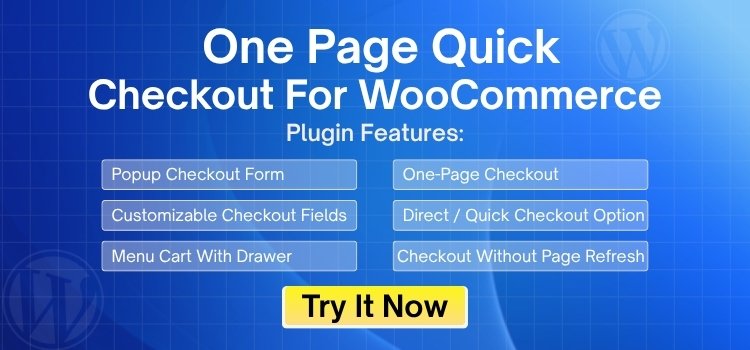Shopping today is all about speed and comfort, and the way people complete their orders plays a big role in that experience. Many stores use checkout methods that save time while keeping things simple. You might already be wondering what is the difference between one-page checkout and one click checkout?
The main difference between one-page checkout and one-click checkout is the number of steps and required input. One-page checkout shows all fields on a single screen and needs user input. One-click checkout skips forms entirely, using saved info to complete the order instantly.
If you are curious about how each method works in real shopping situations, this article covers it all. You will find clear examples, pros and cons, and explanations that show where each option fits best. Reading further will give you the complete picture.
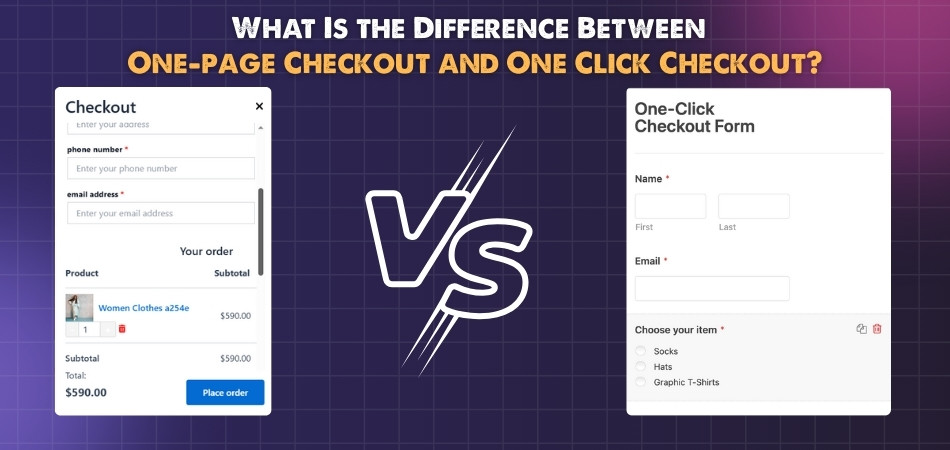
What Is the Difference Between One-page Checkout and One Click Checkout?
When comparing checkout styles, it helps to see the main differences side by side. The table below highlights how one-page checkout and one-click checkout work, making it easy to understand which option fits better for different shopping needs.
| Point | One-page Checkout | One-click Checkout |
| Steps to finish | All steps shown on a single page, user fills in and submits | Order placed instantly with one tap/click |
| Data entry | User must type shipping, billing, and payment info | No typing, details are already stored |
| Account/wallet | Works for both guest and logged-in users | Requires logged-in account or digital wallet |
| Best for | First-time buyers entering details | Returning buyers with saved info |
| Speed | Faster than multi-step checkouts | Fastest possible checkout |
| Payment options | Supports many payment types, coupons, and store credit | Limited to saved card or wallet method |
| Cart review | Easy to edit cart, apply coupons, choose shipping | Often skips cart, fewer editing options |
| Upsells/add-ons | Can show add-ons and upgrades before purchase | Harder to add upsells pre-purchase, usually post-purchase |
| Error/failure risk | More form errors are possible due to typing | Minimal errors since info is prefilled |
| Set up/tech side | Easier to build and test, standard PCI compliance | Needs saved payment tokens/wallets, may need extra security checks |
Steps to finish
One-page checkout keeps everything on one screen. You still review the cart, fill fields, and click a final button to place the order. One-click checkout skips forms and confirmation screens. If details are stored, you tap once, and it processes the order automatically without extra steps.
Data entry
In a one-page flow, you type your shipping address, contact info, and payment details before you can pay safely. Validation may flag mistakes, which slows things down. One-click checkout uses saved info, so no typing is needed. Your stored address and card complete the purchase immediately.
Account or Wallet
One-page checkout usually works for guests and logged-in users. You can pay without creating an account. One-click checkout almost always needs a signed-in profile or a wallet like Shop Pay, Apple Pay, or Google Pay, because it relies on stored, tokenized payment and address details.
Best for
Shoppers without saved details or those leaving special instructions benefit most from one-page checkout. It also helps anyone compare shipping options before paying. On the other hand, one-click checkout is ideal for repeat buyers who trust the store and want maximum speed, especially on mobile where typing is harder.
Speed
One-page checkout is faster than long multi-step forms because everything loads at once. Still, it requires typing and checking. One-click checkout is the fastest path because it uses stored data and places the order immediately. It reduces time from minutes to seconds, which helps conversion rates.
Payment options
A one-page layout often shows many choices, like cards, PayPal, bank transfers, gift cards, and store credit. You can also pick currency and billing address formats. One-click checkout usually limits you to the saved card or supported wallet methods, which can be fewer but very convenient.
Cart review and edits
With one-page checkout, it is simple to update quantities, remove items, add coupon codes, choose shipping speed, or add gift notes before paying. One-click checkout may bypass the cart and place the order quickly, leaving fewer chances to edit details unless the store shows a quick pre-check confirmation.
Upsells and add-ons
One-page checkouts can present add-on products, warranties, or shipping upgrades before payment, which encourages higher order value. One-click checkout aims for instant purchase, so pre-purchase upsells are harder to show. Many stores instead use post-purchase offers on the confirmation page, since the payment is already authorized.
Error risk and friction
Typing brings risk of mistakes, like wrong zip codes or card numbers, which cause error messages and drop-offs in one-page checkouts. One-click checkout limits typing, so there are fewer chances for errors. Prefilled data reduces friction, but wrong saved details can still require fixes later.
Setup and compliance
Solutions like WooCommerce 1 page checkout make setup easier, since everything is built on one screen and follows standard PCI compliance. One-click checkout needs saved payment tokens or wallet integrations, and sometimes strong customer authentication like 3-D Secure, depending on the region and card type.
Pros and Cons of One-page Checkout vs One-click Checkout
Choosing between one-page and one-click checkout depends on how your store runs and what your customers expect. Each style brings clear strengths and tradeoffs. The goal is to keep buying simple without hurting accuracy. Keep reading to weigh the pros and cons carefully.
One-page Checkout
This method places the entire checkout process on a single page. Customers can enter their details, shipping, and payment information without moving through multiple steps. It is designed to make checkout simple and faster.
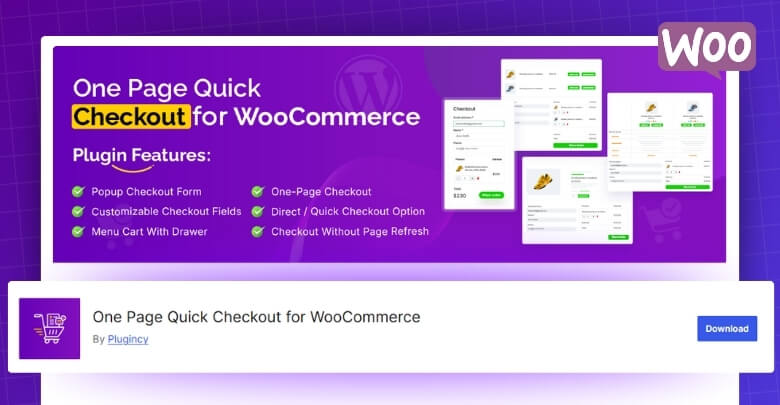
Pros
- Fast checkout with fewer clicks and page loads.
- Smooth flow without interruptions.
- Everything is visible on one screen.
- Reduces cart abandonment.
- Often boosts conversion rates.
- Better page performance with fewer reloads.
- Simple navigation, no need to go back and forth.
- Easy for customers to review orders before paying.
- Works well on mobile if designed properly.
- Provides a more satisfying shopping experience.
Cons
- Page can look crowded if not designed neatly.
- Harder for store owners to see where buyers drop off.
- If a shopper leaves halfway, no details are captured.
- Limited space for showing extra offers without clutter.
One-Click Checkout
This method lets customers complete their purchase with a single click once their details are saved. It is built for speed and convenience, making it especially useful for repeat buyers and mobile shoppers.
Pros
- Super quick checkout with just one tap.
- Perfect for repeat buyers.
- Lowers the chances of cart abandonment.
- Encourages impulse purchases for smaller items.
- Often improves conversion rates.
- Very smooth on mobile.
- Uses secure payment tokens.
- Trusted checkout buttons increase buyer comfort.
Cons
- Shoppers need to save details first before using.
- Not every store supports it yet.
- Usually tied to a specific payment system.
- Better suited for simple or quick buys, less for detailed orders.
- Works best when customers are already familiar with the store.
One reason both one-page and one-click models are popular is that they solve many of the common problems with multi-step checkout, such as long forms and cart abandonment.
How Do One-page Checkout and One-click Checkout Handle Customer Information?
Understanding how checkout pages handle customer details can help you pick the right setup for your store. Below, we’ll look at how each style treats names, addresses, and payments in simple terms. Keep reading to explore the key parts step by step.
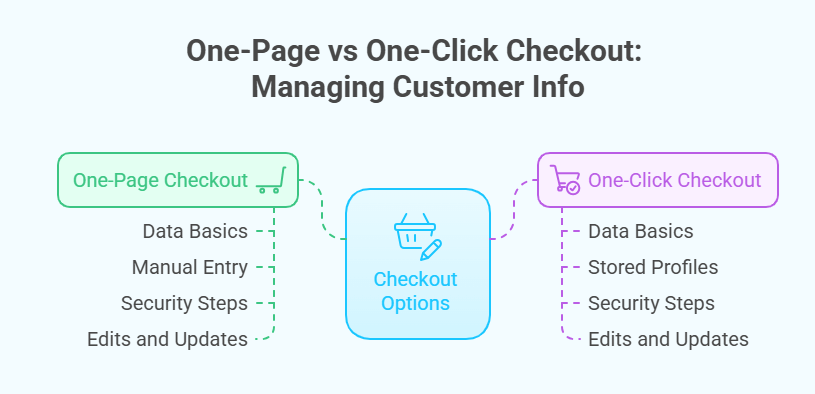
Data Basics
Both checkout styles collect the same core details like name, email, shipping address, and payment method. The difference is how they get them. One method asks for fresh input each time. The other uses saved data to move faster with fewer actions.
Manual Entry
In a one-page checkout, shoppers type their information into visible fields. They fill in name, phone, street address, card details, and any notes. The page checks for mistakes and missing fields. This approach suits new shoppers or anyone who prefers to review everything before paying.
Stored Profiles
Instead of typing information, one-click checkout uses saved addresses and payment data from the store or digital wallet. After signing in or unlocking the wallet, a single tap places the order. No forms appear. This option works best for returning customers who value speed over manual checks.
Security Steps
With one-page forms, card data is entered during checkout and secured by the payment processor. One-click uses tokenized details stored by the platform or wallet, keeping real card numbers hidden. Some orders may ask for extra confirmation, like a code, to reduce fraud.
Edits and Updates
One-page makes edits simple because all fields are on one screen. Shoppers can fix addresses, swap cards, or add delivery notes before paying. One-click moves quickly, so edits happen in the saved profile or wallet settings, then future orders use the updated information.
Both checkout styles handle customer data safely but in different ways. One-page checkout works best for those who like to review and adjust details before paying. One-click checkout is perfect for returning buyers who want speed and ease. Picking the right option depends on your store’s audience and goals.
Which is Faster: One-page Checkout or One-click Checkout?
Checkout speed is very important because it affects sales and customer happiness. Two common checkout methods are one-click checkout and one-page checkout. Both methods can be fast but they work in different ways. Knowing the important factors helps pick the right checkout for speed.
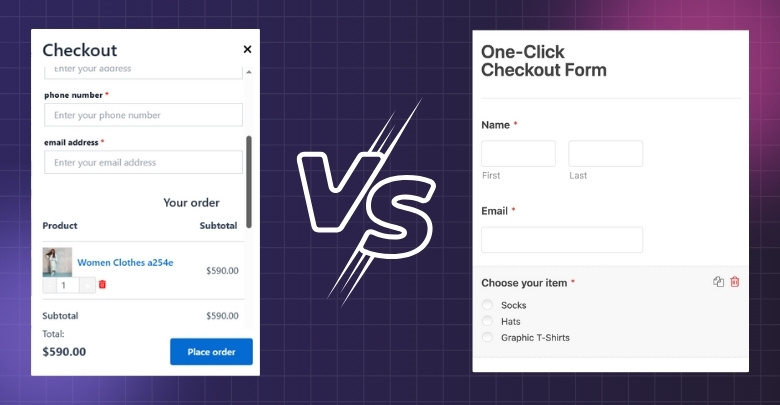
Checkout Steps
A shorter checkout process usually helps buyers finish faster without losing patience. One-click removes extra stages, while one-page combines all actions into one screen. Extra review pages or login requests can slow down progress. Simple flows with clear steps make it easier for buyers to complete.
Form Fields
Long checkout forms often cause delays, especially when using smaller devices. Keeping only essential fields like address and payment improves speed and reduces frustration. Autofill and smart suggestions can reduce typing work and errors. Avoiding unnecessary fields helps buyers stay focused and move forward quickly.
Saved Details
Stored information plays a big role in how fast checkout happens. Returning customers often benefit most since their details are already saved. Trust symbols and clear security checks allow people to confirm faster. Easy editing options help correct mistakes without forcing the buyer to restart.
Device Used
Different devices affect checkout time because typing and navigation change. On mobile, short forms and larger buttons matter for fewer mistakes. Desktops give more space, so longer forms feel easier to handle. Network speed also matters since heavy content can make pages load more slowly.
Purchase Type
The type of product being purchased can affect checkout speed. Low-cost impulse buys work best with fast one-click options. Larger purchases may require careful review and extra verification before confirming. Gift orders or subscriptions often need extra fields, which add more time.
Fast checkout depends on reducing steps, shorter forms, and securely saved details. The right method also depends on the device being used. Businesses should offer both one-click and one-page options for balance. Improving checkout speed brings better sales results and happier returning customers.
When to Use One-page Checkout Instead of One-click Checkout?
Deciding which checkout style works best depends on the type of customers and products involved. Not every store benefits from a one-click option. Some situations call for a slower but clearer process. Let’s explore where one-page fits better.
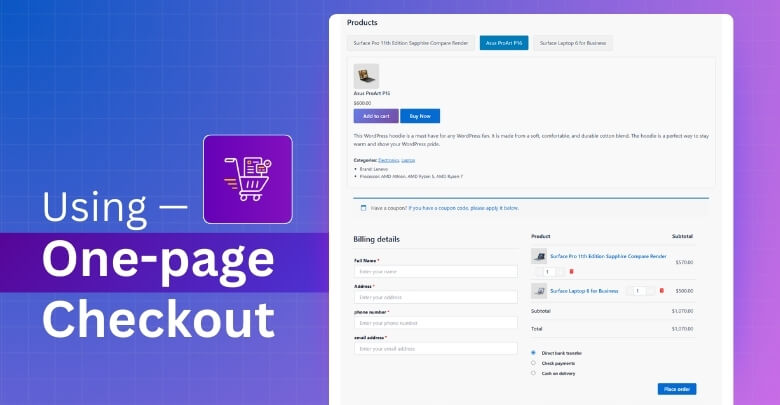
First-time Buyers
New customers often need to enter details like address, payment, and shipping preferences. They may not have saved data or trust the store yet. A one-page checkout lets them carefully review everything before completing the purchase, creating more comfort and fewer mistakes.
Complex Orders
Some businesses sell items that need extra choices, like furniture with delivery instructions or custom-made products with measurements. One-page checkout works better here because customers can see all fields together, check details, and make sure nothing important is missing before placing the order.
Business Purchases
Companies that buy in bulk or require invoices often need to add tax details, company names, or special instructions. One-page checkout provides enough space to capture these extra fields. It also gives buyers a clear view of costs before they submit their order.
High-value Products
When customers buy expensive items like jewelry, electronics, or medical devices, they usually want more control at checkout. One-page checkout allows careful review of warranties, shipping options, and payment methods. This extra visibility makes buyers feel safer before making a big purchase.
Customer Comfort
Not all shoppers like speed. Some prefer to take their time, double-check their order, and adjust details. In situations where first-time buyers need to enter full details, businesses often look at choosing one-page checkout plugins to make the process smoother without overwhelming the customer.
One-page checkout is not about speed alone. It supports complex, detailed, and careful orders that one-click cannot handle well. Stores selling big-ticket items or handling new customers gain more trust through this method. It’s all about matching checkout style with buyer needs.
FAQs About What Is the Difference Between One-page Checkout and One Click Checkout?
Shoppers and businesses often have small but important questions when comparing checkout methods. These FAQs cover the most common queries so you can quickly understand how one-page and one-click checkouts work in real situations.
How Does One-page Checkout Improve the Buying Experience?
One-page checkout keeps everything on a single screen. Customers can see the entire process, including shipping, billing, and payment fields, without moving to new pages. This saves time and makes navigation easier. It also reduces confusion, especially for first-time buyers.
Why Is One-click Checkout Considered Convenient?
One-click checkout is convenient because it uses stored payment and address details. Once these details are saved, buyers only need one tap to complete the order. This makes it very quick, especially for mobile users. It is perfect for people who shop often.
Can Both Checkout Styles Work on Mobile?
Yes, both styles can work well on mobile if designed properly. One-page checkout shows all fields in a scrollable layout, which is simple for users. One-click checkout is even faster on mobile, needing just a single tap. Both can improve mobile shopping when optimized.
Is One-page Checkout More Flexible for Coupons?
Yes, one-page checkout usually offers more flexibility for coupons and discounts. Shoppers can enter codes directly on the page before finishing the purchase. It also allows them to see how discounts affect the total. This makes it easier to apply promotions without missing them.
Do Customers Need Accounts for Both Checkouts?
One-page checkout works for both guests and logged-in users. Shoppers can complete their purchase without creating an account. One-click checkout often requires a saved profile or wallet. This means a customer usually needs to log in or use a service like Apple Pay.
Which Checkout Style Helps With Bulk Orders?
One-page checkout is better for bulk or complex orders. It allows buyers to adjust quantities, add special instructions, and see the full cost before payment. One-click checkout focuses on speed, so it skips many of these steps. This makes the one-page more practical for detailed orders.
How Do Shoppers Edit Their Orders in Each Style?
Customers can easily change items, update addresses, or switch payment methods before paying in one-page checkout. Everything is visible on one screen. One-click checkout often skips the cart, so edits are limited. Buyers must update details in their saved profiles before ordering.
Does One-click Checkout Increase Impulse Purchases?
Yes, one-click checkout often encourages impulse purchases. Since the process is so fast, shoppers may buy items without much review. This works well for small or everyday items. For expensive or complex products, buyers might prefer more control with a one-page checkout.
Is One-page Checkout Easier to Set Up for Stores?
One-page checkout is usually easier for store owners to build and test. It uses standard payment methods and follows common security rules. One-click checkout needs extra integrations like wallets or token systems. This makes one page simpler for small businesses to start with.
Which Checkout Style Builds More Trust With New Shoppers?
One-page checkout builds more trust for new shoppers. They can carefully review every detail before paying. This slower but clearer process gives them confidence in the purchase. One-click checkout works better once trust is already established and details are stored.
Conclusion
The way shoppers complete their purchase depends on speed, trust, and details. One-page checkout gathers all fields on a single screen, while one-click relies on stored information for instant buying. This explains clearly what is the difference between one-page checkout and one click checkout.
When choosing the right method, think about your products and customers. Use one-page for detailed or high-value orders, and one-click for quick, repeat buys. Keep the process simple, test your checkout often, and good luck creating a smooth shopping experience.
